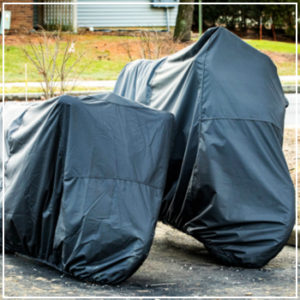
When a motorcycle is left uncovered, it doesn’t take long for the outdoor elements to affect its main components. While age can play a factor – newer models are designed to handle UV rays, moisture and cold better – any bike left outside can succumb to corrosion, cracked seals and rusted bolts.
To avoid these issues, you need to keep your ride covered. Experts recommend storage in your garage or another climate-controlled shelter, but what if these options aren’t available to you? Consider a motorcycle cover that’s designed to breathe, keep out moisture and shelter the bike from inclement weather conditions.
Finding the Right Cover
Not all motorcycle covers are created equal. You may come across canvas, medium and heavy-duty polyethylene, and vinyl varieties. The goal is to find a sturdy material that offers UV and moisture-resistance but still provides a degree of breathability to prevent water droplets from getting locked in.
For long-term storage, you’ll want to look for waterproof, puncture-resistant materials that offer venting and include a soft fabric liner to lessen scratches to the finish.
Avoid selecting a light fabric motorcycle cover. These can blow off and tear easily after long-term exposure to the elements and won’t provide the degree of protection your bike needs.
Clean Your Bike
Dirt and debris can do more than dull your motorcycle’s finish. Long term, these particles can accelerate rusting and cause the metal to develop a pitted appearance. With this in mind, thoroughly wash off your motorcycle before covering it for long-term storage.
As moisture can also contribute to corrosion, let the bike fully dry. If you’re winterizing for the season, go through the usual steps of lubing components and replacing fuel and fluids. Focus on the essential parts for operation that can rust quickly when exposed to moisture.
Secure the Cover
It’s not advised to simply toss a cover on your bike – you want a close fit that won’t blow off. Make sure you have clips, tie-down cords or bungee cables to secure the material.
Start by laying the cover on the windshield area, then place it over and around the seat. Once these areas are covered, move it down to cover the pipes, back and front wheels. As soon as everything is covered, secure the ends together to keep the material in place.
What’s your approach for bike storage? Share your methods on our Facebook page.
